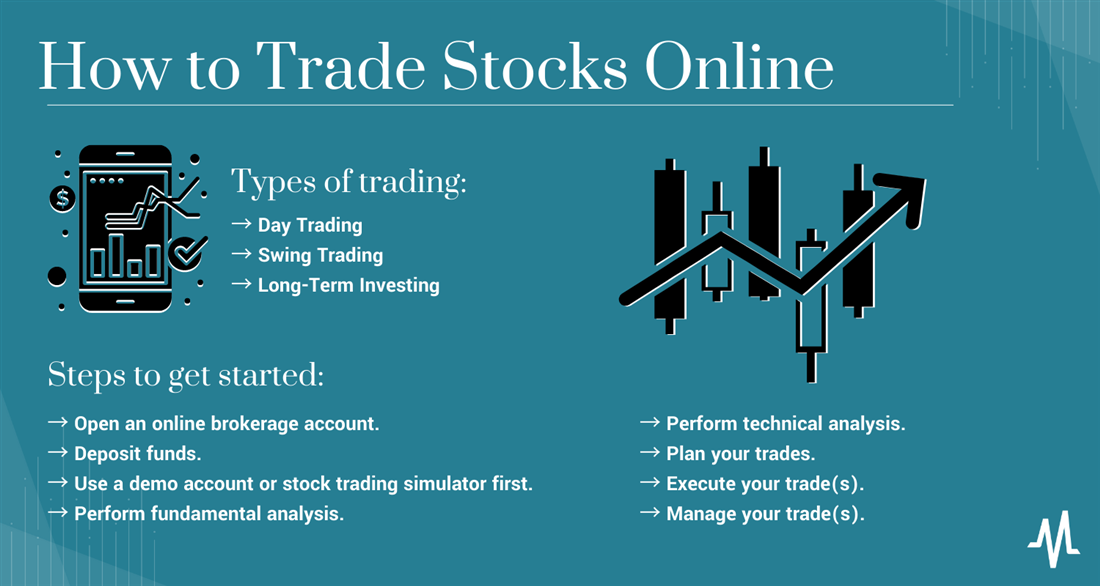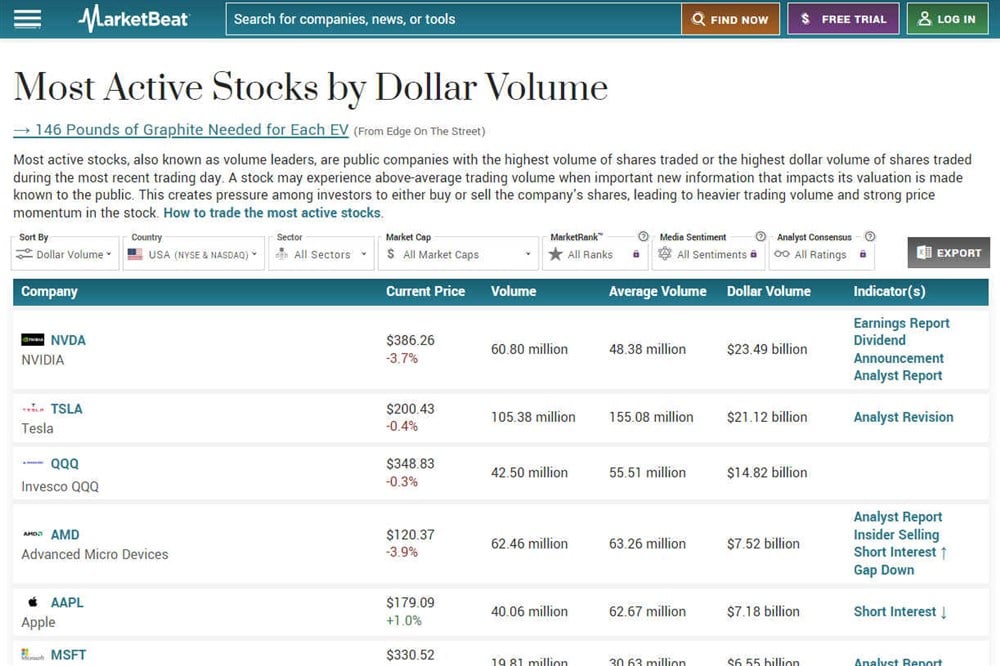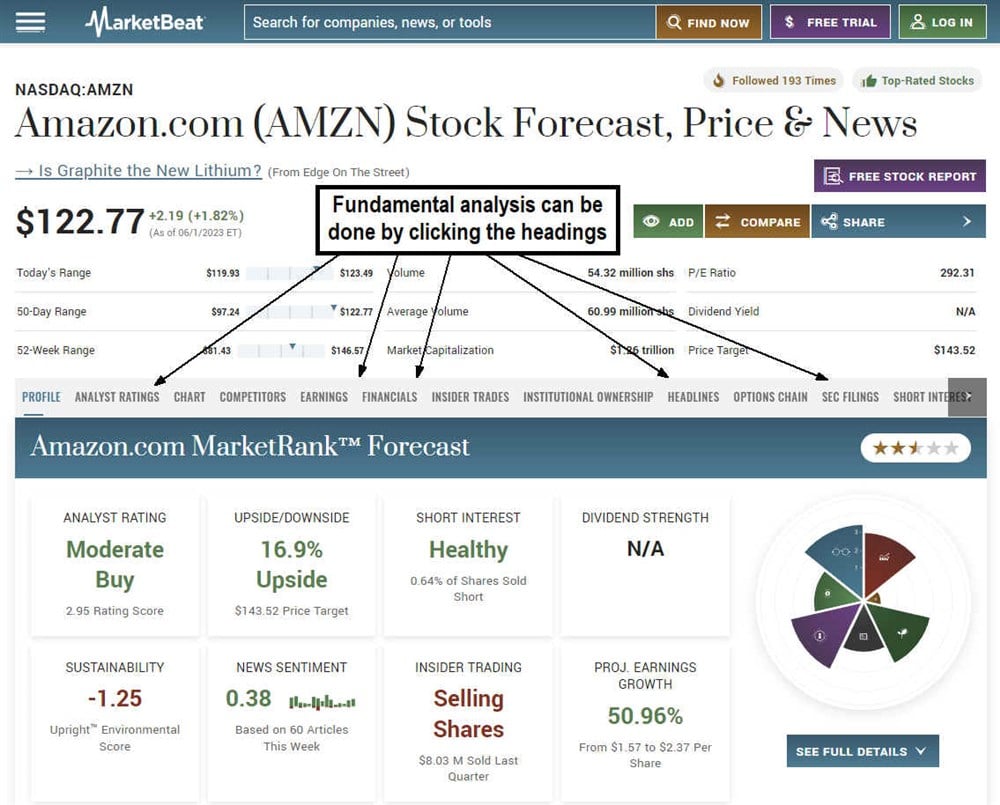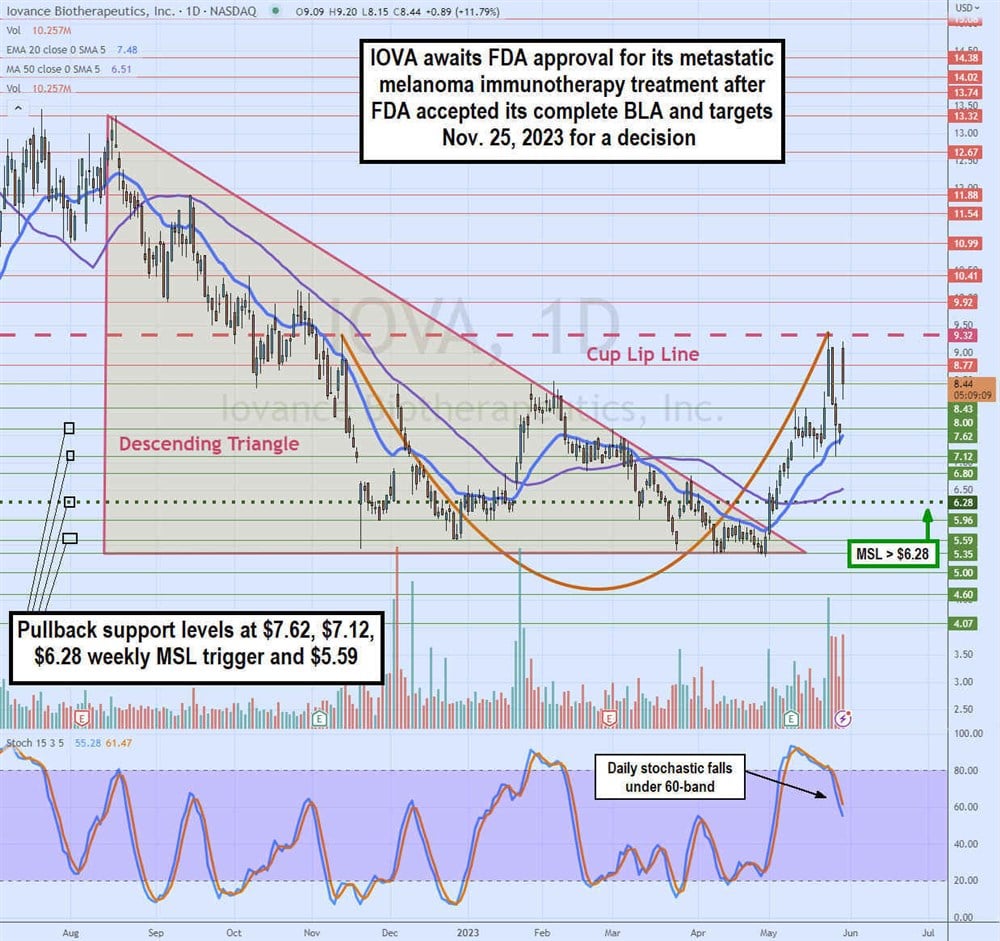
Hearing about the stock market and investors making money can motivate you to consider trading stocks online. Unfortunately, too many people jump into day trading without understanding the basics and fall right into the traps of impulse trading, FOMO and bag holding.
You want to avoid the deer-in-the-headlights situation when you rush into a trade without a plan. Patience and discipline are two crucial and necessary traits for survival and longevity in trading.
This article will help you navigate learning how to trade stocks online. We will review the basics and identify the pitfalls to prepare you for buying stocks online. When you finish this article, you will have more insights to make more informed decisions regarding online stock trading.
What Does it Mean to Trade Stocks Online?
Buying stocks involves using a licensed brokerage. In the old days, before 1990, investors would get their stock quotes from the newspaper in the financial section.
To buy or sell a stock, you must have an account at the stock brokerage and have a licensed stock broker place the trade for you. Commissions were expensive, as they were often a percentage of the total cost of the trade.
For example, a 1% commission meant that if you bought 1,000 shares of a $100 stock, you would pay $1,000 in commission to buy the stock and another $1,000 to sell the stock. With such expensive commissions, few investors traded. The advent of discount stock brokers like Charles Schwab introduced much cheaper commissions that enabled investors to make trades for $50 instead of $500. This helped draw more retail investors into the stock market.
E-trade offered online trading in 1992. Online trading involves manually placing stock trades through a computer and an internet connection through an online broker. Stock trading commissions fell tremendously in the late 1990s with the introduction of online trading and electronic communications networks (ECNs). The advent of the internet and increasing bandwidth speeds enabled self-directed investors to place their trades at discounted commissions, ranging from $10 to $20 per trade.
Charles Schwab enabled investors to place automated trades by phone and provided online access to trade online through the internet and a computer connection. In 1996, electronic brokerage firm Datek started an ECN called Island, an electronic order book that matched buyers and sellers without needing a middleman like a market maker or specialist. Investors and traders with direct access brokers could route their online stock trades to the ECNs for quicker and often better price fills. As more ECNs sprouted, like Archipelago, BRUT and EDGE, online trading became more accessible and democratized.
Until Island, the institutional ECN was Instinet, aka "INCA," in a level two screen. Eventually, Instinet purchased the Island ECN. The advent of electronic trading led to a day trading bubble that saw internet stocks (dot.com bubble) lead the rally in the Nasdaq, doubling to 5,048 in March 2020 before collapsing more than (76%) to 1,139 by October 2002. Eventually, the Nasdaq recovered back through 5,000 in April 2015, just over 15 years later.
Fast forward to 2023, and the commissions have fallen from $10 to $5 to $0 in large part due to mobile brokerage Robinhood’s zero-commission trades started a domino effect, as discount brokers had to switch to zero commissions to compete. Charles Schwab went zero commissions in 2019, which caused others to follow suit, like TD Ameritrade, E-Trade, TradeStation, Interactive Brokers and many smaller online brokers.
Most online brokers offer zero-commission stock trades. Direct access brokers may charge commissions based on the number of shares, like $0.005 per share or $5 for 1,000 shares. Online stock trading saw a surge during the pandemic as more people were in lockdown at home with stimulus checks prompting a big wave of speculative trading driven by the ”meme” stock wave that saw shares of GameStop Corp. (NASDAQ: GME) rise from $4 to over $500 in a matter of months. During both day trading bubbles, many people made money trading stocks online, but even more lost money. They are cautionary tales that anyone considering trading stocks online must learn from.

Trading vs. Investing
Trading and investing both partake in buying and selling stocks. However, there are some very fundamental differences as it relates to how. Here are some of the key differences:
- Timeframes: The critical difference is the holding time frame for your positions. Trading uses a shorter holding time which can range from minutes to days. Investing is often called buy and hold, where you take a position and hold it for months to years. Active traders tend to concentrate their activity intraday during market trading hours.
- Management: Trading involves active management. It requires you to be acutely sensitive to price fluctuations, trends and news. It requires constantly watching prices, level two screens and charts to make split-second decisions on your trades. Investing implements passive management, where you may check on your positions quarterly or yearly. Investing is a set-it-and-forget-it endeavor where you don't worry about short-term price fluctuations as you focus on the long-term results.
- Risk: Trading can be risky since it tends to incorporate more leverage utilizing margin. Margin accounts can use up to four times your capital during the day and two times in overnight situations. Trading tends to use more capital to take larger positions for shorter periods, focusing on quick incremental price gains. Investing tries to keep shares smaller to absorb larger price swings with less leverage since margin interest can chew up gains. Trading also involved short-selling — borrowing shares on margin to sell and buying back on a price drop pocketing the difference. Short selling is inherently risky as the losses can be infinite, whereas investing focuses only on holding a long position where the risk is limited to the capital invested.
- Activity volume: Trading focuses on quick buy and sell transactions called roundtrips. Traders generate exponentially more round trips than investors. Investing focuses on long-term holds after buying into a position. Eventually, you will sell the position less frequently than a trader.
Trading seeks to profit from price oscillations focused on taking profits and administering stop-losses quickly before they get too large. Investing seeks profits from holding stock for more extended periods.
Types of Trading
Now that you know that traders buy and sell stocks more frequently than investors, let's delve into the different types of trading.
Day Trading
Day trading entails buying and selling stocks during the market trading day and finishing in cash. Day trading assumes that any overnight holds are too risky and closes out all positions in cash to avoid overnight risk.
Day trading captures small profits with more significant share size positions held for smaller periods. Day traders utilize the 4x intraday margin and will short-sell a stock as generally as they would take it long. Day traders must also maintain at least $25,000 in capital in trading accounts to make unlimited round trips.
If the account balance falls under $25,000, it triggers the PDT rule, which allows only three roundtrip trades during a rolling five-day basis. Day trading tends to focus on technical analysis utilizing charts more than fundamental analysis utilizing news.
Swing Trading
Swing trading involves taking positions overnight and several days to weeks. It incorporates the mechanics of day trading and introduces a longer holding period taking on overnight risk. Swing trading also incorporates fundamental analysis along with technical analysis. Swing trading naturally involves fewer round trips. It can still involve margin, especially if swinging a short position. Swing trading uses less leverage since the margin is two times for overnight positions.
Long-Term Investing
Investing is assumed to be long-term. Long-term can mean holding a stock position for years. It doesn't focus on the intraday price fluctuations as investors consider this "noise." Instead, they seek more significant price swings and bigger gains focusing on the long-term business.
Blue chip stocks and dividend stocks are often used for investing. Dividend stocks can compound the gains, mainly if reinvesting them. Long-term investing uses fewer shares and spreads the risk through diversification, especially when holding a long-term investment portfolio.
How to Trade Stocks Online
If you've decided to plunge into trading, here are some steps to get you started. Therefore, trading is considered high risk, so do not jump headfirst into it. Make sure you do much research and take advantage of the numerous resources available for research. Always be a student. The learning never ends. Here are the steps to help navigate your entry into how to trade in the stock market online and invest stocks online.
Step 1: Open an online brokerage account.
There are so many choices when it comes to online brokerage accounts. It depends on the type of trading you want to do. For day trading, it's best to go with larger brokers with desktop platforms with charting, newsfeed, demo or trading simulators, research tools (screeners, high-of-the-day lists, pattern scanners), level two access and even direct order routing. These platforms are tailored for active trading and have live customer support to help you handle any issues on your trades, account, or software. These brokers vary from zero-commission to per-share or flat-rate commission schedules.
You can consider online brokers or app-based zero-commission brokers for swing trading or investing. If you plan on being less active, you can go with these brokers because they have more straightforward interfaces and fewer account minimums, especially if you have less than the $25,000 requirement to day trade. These brokerage platforms may have only some bells and whistles and customer support may be limited to email or messaging. Still, they are convenient, minimal and portable platforms suitable for beginners. Remember that trading is risky and, therefore, unsuitable for IRA or retirement accounts. You also can’t use margin or short sell in a retirement account. Any funds used for trading should be risk capital only. Investing is more suitable for IRA accounts with a long-term holding horizon.
Step 2: Deposit funds.
Once you've selected an online broker and completed the application, it's time to fund the account. Brokers allow many ways to fund the account from a checking or savings account. You can deposit using ACH, checking or wire transfer. Many brokers may only provide real-time quotes if you deposit to fund the account first. Mobile online trading app brokers tend to be more generous regarding free real-time quotes, but they can vary.
Step 3: Use a demo account or stock trading simulator first.
It’s highly advisable to use a demo account initially to get comfortable with the steps to trade stocks online. As mentioned, the more prominent online brokers tend to have desktop software with a demo version or a simulator, enabling you to place trades and practice without using actual cash. Most of the larger online brokers offer a demo account to try. However, they may require you to have an actual funded account to use it.
Learn on the demo or simulator first. When you use actual cash on a trade, it can change the whole dynamic. The numbers on the screen become real, and losses can trigger a deer-in-the-headlights situation. Another famous quote from boxing heavyweight champion Mike Tyson, "Everyone has a plan until they get punched in the face." This also applies to trading. As you get more successful with the demo, you can slowly ease into cash trades with smaller sizes. The key is not to start with 1,000 shares but to gradually increase your comfort zone.

Many resources and rich resources like the MarketBeat Originals articles provide stock ideas every day to consider trading. You can select stocks based on sectors, industries or themes. Start with a list of five stocks and add more as you get familiarized with them. It is essential to ensure the candidates have the features needed to make it worthwhile to take a position. We will review those features a little later in this article.
Step 4: Perform fundamental analysis.
Fundamental analysis is research on a company’s business. Research the services and products offered by the company and its competitors. Read through its latest 10-K quarterly reports, press releases and earnings conference calls. Read through analyst reports and articles so that you can explain the business and the company to another investor. Research the common metric ratios like price-earnings (P/E), price-sales (P/S), cash per share (CPS) and free cash flow.

Compare the stock to others in the industry to see how it fares. Study the balance sheets and income statements and develop a thesis for why you want to invest in the stock. Is it undervalued? Are there catalysts for the price to go higher? What is the value proposition? What is the competitive advantage?
Step 5: Perform technical analysis.
Technical analysis is the study of price action using charts. Candlestick charts are a common type to start with. Be sure to read up on basic chart patterns and learn to identify breakouts, breakdowns, triangles, flags, cup-and-handles, head-and-shoulders, double tops and double bottoms.

You want to identify the trend, support and resistance price levels. From there, you can devise a plan for trading that stock. Once you have identified support levels to consider buying and resistance levels to consider selling and breakout and breakdown levels for stop-losses, you can start focusing on your trading plan.
Step 6: Plan your trades.
There is a common saying among traders, “Plan your trade and trade your plan,” and it’s easier said than done. Once you have the entry and exit price levels based on the trend, support and resistance levels, decide the type of entry and exit you want.
For your entry plan, do you want to scale into a position using multiple entries to get a better average or enter in a single trade? Decide how much capital to deploy or how many shares to buy for your position.
Remember, the more shares you hold, the more risk you experience. Have your exit plan for both profits and losses. A stop-loss is the price level where you exit your position to avoid further losses. A profit-stop is a price level where you will sell your position for a profit. A profit stop can be trailing as well, meaning the stop area rises with the rising price to ensure locking in profits before it reverses. It's time to execute once you have your trading plan ready.
Step 7: Execute your trade(s).
Place your trades on your online brokerage platform. Use limit orders as much as possible to avoid impulse trading or chasing entries and exits. Limit orders let you predetermine your entries and exits to think ahead and be ready to trigger.
Be careful using market orders as they can fill quickly, but you could inadvertently be paying top dollar chasing a stock price. Limit orders enable you to keep a cool head. With each execution, you will be entering your position(s). It doesn't end here. Once you enter, you must manage the trade and the exits.
Step 8: Manage your trade(s).
A slowing down or reversal of the premises you had for entering your trades will be the reason for exiting the trade. For technical price patterns you're entering may be based on a breakout through a certain price level at the start of an uptrend. Your exit will be if the uptrend fails or slows down.
As the stocks reach certain price levels, you must be disciplined to appropriately exit some or all of your shares. If you're day trading, you need to close out your positions before the end of the day to incur no overnight risk.
If you are swing trading, ensure you are aware of the potential price gaps against you should there be overnight news. You will still need a stop-loss, but they are usually larger on swing trades, which require a smaller position size.
Terms to Know
Here are some often-used terms you will encounter in your trading journey.
- Ask: This is the price that willing sellers offer you to consider buying.
- Bagholder: This term describes an investor that got sucked into chasing and overpaying for stock and being "stuck" in the position as it dropped precipitously from the entry price and is unwilling to sell for a significant loss.
- Bid: A bid is a price for which buyers are willing to buy your stock and is quoted on the left side.
- Candlestick: This type of stock chart utilizes "candlestick" like plots consisting of a body representing the opening price and closing price followed by wicks representing the high and low for that period.
- Downtrend: This is a price pattern of lower lows and lower highs.
- Dumper: This is a stock that has gapped down more than (10%) in price due to negative news like a poor earnings report.
- FOMO: Fear of missing out (FOMO) is the feeling of being left out of profits by not taking a position in a rising stock, often accompanied by impulsively chasing an entry at high prices.
- Gapper: This stock is priced 10% or higher pre-market from good news like an earnings guidance raise.
- Impulse trading: This is trading emotionally chasing stocks without having a trading plan to be in the stock.
- Level 2: This is a data feed from the exchanges like NASDAQ, which provides market-depth information on the demand and supply of incremental price levels for the stock.
- Long: This is your position when you buy a stock anticipating the price increase.
- Margin: This loan from your stock broker enables you to buy multiple of your account capital worth of stock as long as you meet the maintenance margin. Margin lets you place trades immediately after closing them without waiting three days to settle officially.
- Margin call: When your stock falls in value beyond a certain percentage of your account capital, you can incur a margin call requiring immediate deposit of funds or liquidation of some or all of your stock position. This also applies to short-sell positions that run up too high as losses mount.
- Pattern day trader (PDT) rule: This rule by FINRA requires a minimum of $25,000 capital in an account to place unlimited trades intraday. Falling below $25,000 in capital triggers the PDT rule, which only allows for a maximum of three round trips on a rolling five-day basis. The rule intends to protect traders from taking on too much risk.
- Resistance: A price levels well, and sellers have ample stock to sell, preventing prices from rising any further and causing shares to fall.
- Roundtrip: This is a complete buy and sell sequence during one trading day. Buying a stock opens the position, and selling the stock closes the position in a single day. This sequence, when completed, is defined as a round trip.
- Screener/scanner: This software or platform feature will scan the market to find stocks that meet configurable or preconfigured criteria. The criteria can be based on many fundamental criteria.
- Short sell: This is the opposite of a long position. Stock is borrowed and loaned to you from the broker to sell first in anticipation of a price drop. You would cover the position by buying back the stock at a lower price (ideally) which is then returned to the broker. Short positions are only available in margin trading accounts. If the stock price rises too high and too fast, it can trigger a margin call and a short squeeze.
- Short interest: This is the number of shares or a percentage of the float of a stock that has been sold short and has yet to be covered.
- Short squeeze: This is when too many short sellers cover their positions by buying the stock, causing the stock price to rise, which triggers more short sellers to cover their positions. It also causes buyers to chase higher prices. This presents a phenomenon of rising demand and dwindling supply jamming prices higher as short sellers desperately attempt to control mounting losses.
- Stop-loss: This is the price level where you will exit a position for a manageable loss to avoid losses getting much more considerable.
- Support: These are price levels where buyers are willing to buy stock and demand is strong.
- Uptrend: This is a stock price pattern of higher highs and higher lows.
- Average trading range (ATR): The average range between the stock's low and high prices during several days.
- Trendline: This visualizes an uptrend or downtrend when connecting the highs and lows on a chart. Trendlines can be horizontal and vertical. Most charting platforms enable the ability to draw trendlines.
- Volume: The total number of shares bought or sold during the day.
Features to Look for in Stocks to Trade
When selecting stocks to trade, there are certain features you want them to have. Not all stocks trade the same. Growth and technology stocks are suitable for trading as they carry the most features. Certain features can make a stock more tradeable than others.
Remember that stocks may adopt some of these critical features when a news event occurs, like an earnings report. However, the features may thin out afterward. Trade when the key features present themselves.
Many of these critical features usher in other vital features. For example, an earnings report can spike a stock's volume, volatility and liquidity for two days before it returns to normal. Those two days can be the most opportunistic period to trade before interest and volume revert to normal.
Price Volatility
Volatility is key when it comes to trading a stock. Stocks with significant price swings, breakouts, and breakdowns that oscillate frequently are ideal for online trading. The stock needs to have movement to profit from the price fluctuations. You can use the beta reading to get an initial feel for volatility. Stocks that move with the S&P 500 have a beta of 1. Stocks that move double have a beta of 2. Stocks that move 50% of the S&P 500 have a beta of 0.50. The higher beta stocks tend to have more volatility.
Trading Volume
Stocks trading at 2x or higher volume tend to have more interest and participants. This presents an opportunity. Look for stocks trading at multiples of their average daily trading volume. Higher multiples tend to result in more significant price moves and liquidity, indicating more participants trading the stock.
Catalysts or News
News is the most common catalyst to move a stock. Some news items are scheduled, enabling traders to prepare for them, like earnings reports, FDA decisions, court decisions, product events and announcements and investor day. Other news items like analyst rating changes, earnings warnings, regulatory violations, lawsuits and recalls can be random. Make sure you don’t impulse trade on the news. Insider buying can be a bullish catalyst, especially when the CEO or high-ranking board members buy.
Correlation
Stocks tend to move in groups as peers and competitors in the same industry move together. It's also helpful if your stock has peers that it moves with. Each industry tends to have a "general," a first-tier mover. If the general move is strong enough, then the buying flows down to the lower-tier players in the industry. This enables you to follow a "lead" stock that will move ahead first, allowing you to step in on a lower-tier stock that can follow on sympathy as a laggard.
Liquidity
Liquidity lets you buy and sell a stock without giving up too much slippage on the spread. Liquidity is a product of heavy volume and a thick stock float. Higher-priced stocks tend to have wider spreads between the bid and the ask.
Strong liquidity means the spreads are tighter. For example, if stock A has a bid/ask of $27.78 x $28 and stock B has a spread of $27.78 x $27.80, then one can assume that stock B has more liquidity. Stock A has a 22-cent spread between the bid and asks, while stock B has only a two-cent spread.
If you buy on the ask, change your mind, and sell on the bid, you will lose 22 cents on stock A but only two cents on stock B. Always check the spreads to gauge liquidity.
How to Manage Risk
The goal of risk management in trading is to limit losses and eventually eliminate risk completely by selling your positions back to cash. Cash is the risk-free position. In this sense, consider the risk the same as exposure. Any time you take a position, you take on exposure and have the risk of losses. Managing risk involves having a trading plan with entries and exits based on trend, support and resistance levels buoyed by chart patterns. The share allocation is also critical for proper risk management. A larger share size position takes on more risk than a smaller one. Holding time is also a risk factor. The longer you hold a position, the more risk it entails as the probability of negative news or market reversal rises. Risk is controlled by controlling your share sizing and holding period for your stock position(s).
However, it’s essential to understand that underlying stock price moves do not matter as much as the actual dollar profit or losses it generates. A 1,000 share position for stock A that moves down 25 cents generates a loss of $250. It's the same as a 100-share trade on stock B that moves $2.50, generating a loss of $250. Therefore, be aware of the stock's ATR and allocate shares accordingly.
The Very Real Learning Curve
Trading is not something that you can learn in a matter of days or weeks. Learning how to trade stocks online takes time and diligent effort. It’s not just about buying stocks online. It involves buying stocks and selling stocks with a plan.
There is a very real learning curve involved, and it can be costly. It's essential to spend time and even money on educating yourself on stock trading. Notably, identifying trading patterns and methods is an excellent area to focus on.
Expect to progress slowly and soak up everything you can about trading. Learn how to invest in stocks yourself or learn to trade stocks utilizing various sources. Expect to lose initially and consider that "tuition." There are many resources on MarketBeat to help you find stock candidates and perform research to help you make more informed trading and investing decisions.
FAQs
Here are answers to some frequently asked questions about beginning stock trading.
How to do trading online for beginners?
Beginners should take it very slowly and absorb as much information about trading and researching beforehand. Consider using a demo account or stock trading simulator with an online broker before trading with cash. Follow the eight steps above to get started.
How do beginners buy stocks?
Beginners first need to open an online trading account with an online broker. There are many brokers offering zero-commission trades to choose from. It's also essential to see if their trading platform offers charting tools, screeners, news feeds and more resources to help you spot and manage opportunities.
What kind of trading is best for beginners?
Every beginning is different. It's a matter of preference and persona. Some beginners prefer to swing trade, especially if they have some experience investing in stocks. Some beginners like to start with day trading. It calls for closing their accounts to cash daily to avoid overnight risk. However, day trading requires at least $25,000 capital in the account or else be limited to three round trips per every rolling five-day period under the PDT rule. This may force beginners to start with swing trading.






